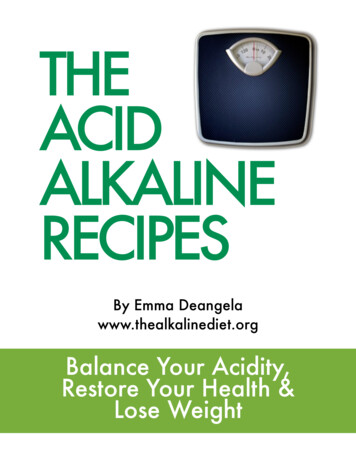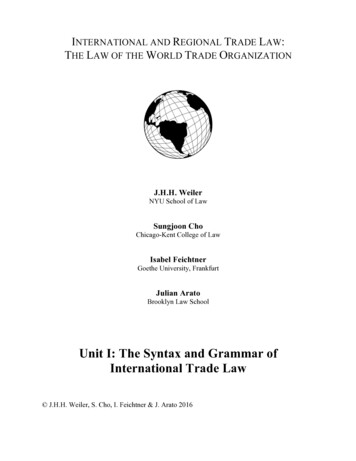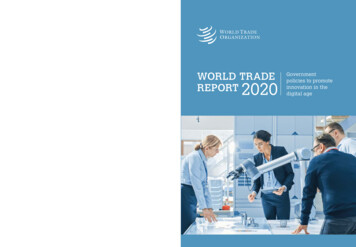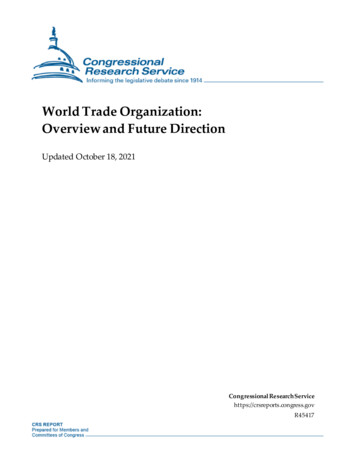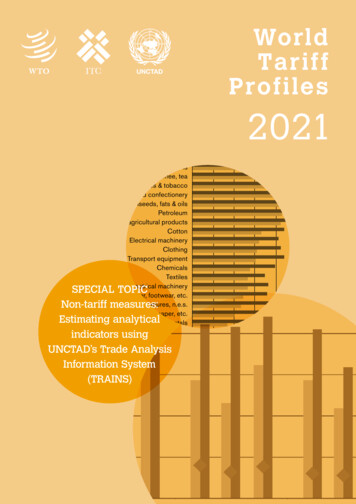
Transcription
The WTOat TwentyChallenges andachievements
The WTOat TwentyChallenges andachievements
3ContentsWTO “widening” –Foreword by WTODirector-GeneralRoberto Azevêdo1Introduction06more members,more participation20Accessions: buildinga 'global' WTO21Empowering developingcountries27Conclusion332Building a tradeorganization –strengthening the institutionalfoundations for global tradecooperation10Establishment of the WTO –the building of a permanentinstitution11WTO Secretariat16Negotiations in the WTO16Conclusion1924WTO“deepening” –reducing barriersand expanding rules34Consolidating andexpanding tariff commitments35Consolidating and expandingthe regulatory framework fortrade in goods37Consolidating and expandingthe disciplines on trade inservices45Modernizing and expandingthe reach of disciplines ongovernment procurement47Conclusion49
5Improvingtransparency –8strengthening monitoring,surveillance and consultation 50Reviewing trade policies toencourage policy dialogue51 onitoring trade policies toMunderstand trends and containprotectionism53Monitoring anddocumenting RTAs54Increasing transparencythrough notifications55Conclusion58Strengtheningoutreach –778Conclusion81Strengtheningpolicy coherence –6Dispute settlement –clarifying rules andresolving disputes60An accessible disputesettlement system61Establishing a rules-basedsystem for resolving disputes62cooperation with otherorganizations68Expanding policy coherence:Art III.5 and beyond69Coherence in action74Conclusion779ConclusionLessons, issues, and principlesfrom 20 years of WTO case-law 64Conclusiontowards enhancedengagement67382
Foreword by WTO Director-GeneralRoberto AzevêdoWhen the World Trade Organization was launched20 years ago it represented more than a reform ofthe old GATT system. The WTO was seen as the keypillar of a new kind of global economic order – open,inclusive, cooperative – that was taking shape inthe wake of the end of the Cold War. Countries thatwere largely closed to the world economy for almosthalf a century were turning to open markets andeconomic integration. Many developing countries, fordecades left behind by the more industrialized, werebeginning a rapid economic catch up. New transport,communications, and information technologieswere weaving economies more tightly together,reshaping international relations in the process. Ifthe GATT was the product of a divided world, theWTO offered the promise of a more unified one.elimination of all remaining global tariffs. The July2015 agreement to expand the scope of the WTOInformation Technology Agreement (ITA) promisesto eliminate tariffs on high tech products whichrepresent 7 per cent of global trade – more thantrade in textiles, apparel, iron and steel combined.Meanwhile the WTO as an institution providesa key forum for policy dialogue, informationsharing, and economic cooperation among its161 members – making it an increasingly criticalpillar of today's system of global governance.Most importantly, the WTO has helped tounderpin an unprecedented period of wideningglobal growth and development. Since 1995, thedeveloping countries' share of global merchandisetrade has grown from 27 per cent to over 43 percent – and their share of global GDP has risenfrom 41 per cent to over 53 per cent. Emergingeconomies such as China, India, and Brazil havebecome indispensable drivers of the global economy,as well as leading voices in the internationaleconomic system. There are many reasons whydeveloping countries have achieved economiclift-off, but surely none is more important than theirintegration into the global economy – a processthat has depended, in turn, on today's extraordinarilyopen, reliable and secure world trading system.So far the WTO has lived up to theseexpectations. Thirty-three new members have joinedsince 1995, including giants like China and Russia,meaning that almost all of the world's economiesare now part of a single trading system. Internationalrules, not power, increasingly govern trade relations,and conflicts are settled, not in trade wars, but in theWTO's dispute settlement system – which servesas a global trade court. Trade barriers continue tofall – to the point where well over half of global tradeis now tariff free – and economies are becoming evermore interconnected. While progress in the DohaDevelopment Agenda – the latest in a long line oftrade 'rounds' – has proved very difficult, a growinglist of new WTO agreements – covering everythingfrom customs reform, to information technologyproducts, to government procurement, to financialand telecommunications services – are opening upnew trade opportunities, in new sectors, often ininnovative ways. It is estimated that the 2013 WTOTrade Facilitation Agreement alone could have abigger impact on reducing trade costs than theThis book is intended first and foremost to bea reminder of these achievements – achievementsthat are sometimes overlooked amid the day-to-daychallenges of managing an increasingly complex anddiverse global trading system. Prepared by the WTOsecretariat, it provides a detailed and factual look atthe WTO's activities and accomplishments over its firsttwenty years. The WTO's short history is obviously notone of unbroken success – disappointing progress4
The wto at twenty FOREWORDThe WTO is ultimately the result, not thecause, of members' willingness to cooperate ontrade. Its creation and subsequent success reflectsthe growing realization among more and morecountries that trade opening can lead to growthand development, that agreed rules strengthen, notweaken, sovereignty, and that advancing our nationalinterests increasingly depends on advancing ourcollective interests. As today's global economy growsincreasingly open, interdependent and multipolar, itis clear that international trade cooperation, and theworld trading system, is becoming more, not less,important. But just because the WTO is importantdoes not make it invulnerable. The WTO's first twentyyears have been successful because of members'decisions; whether its next twenty years are assuccessful will be up to the members as well.in the long-running Doha Round is a lingering andhigh profile reminder. But as the following pagesmake clear, the WTO's contribution to the worldeconomy in general, and to development in particular,is much broader than the Doha negotiations,even as they remain a key element of our work.In looking back at the WTO's achievements,the book also serves as a reminder of how hard wehad to work to make the system what it is today.Non-multilateral initiatives will naturally continue toblossom, but we must maintain the WTO as a strongand comprehensive foundation of global trade. TheWTO was not the first attempt to create a globaltrading system, nor the first time that policy makersaimed to realize the vision of global peace throughshared prosperity. After the Second World War, theinternational community also saw the building of anopen global trading system as essential precursorto building a new post-war international order.But the bold plan to create an International TradeOrganization soon fell victim to Cold War rivalriesand waning support for internationalism. It was notuntil the WTO's creation five decades later that thedream of a permanent and global trade organizationwas realized – making the WTO the first trulyinternational institution of the post-Cold War era.Roberto AzevêdoDirector-General5
1The headquarters of the WTO in Geneva, Switzerland.6
The wto at twenty CHAPTER 1Introduction1947, the WTO now has 161 — a fifth of whom havejoined since its launch. With the accession of giantslike China in 2001, Saudi Arabia in 2005 and Russiain 2012, all of the world's major economies are nowpart of a single economic system – covering 98 percent of global commerce – for the first time. And whileindustrialized countries dominated the GATT, developingcountries play a key role in managing the WTO,shaping its agenda and negotiating its agreements.That the WTO is successfully integrating a fast-risingdeveloping world – easily the biggest economictransformation in history – into an open global economyrepresents one of its most significant achievements.The WTO's first 20 years have certainly not beenwithout challenges. Its Doha Round of tradenegotiations has made slow progress as WTOmembers grapple with the tough and complex issuesraised by deepening integration. Its dispute settlementsystem is dealing with a growing number of tradeconflicts – often involving the biggest trade powersand the most contentious policy questions – as theworld's economies become more intertwined. As amain locus of global economic coordination, the WTOalso finds itself at the centre of growing debatesabout globalization, development, climate changeand many other issues that now transcend nationalborders – placing the world trading system in thepublic spotlight as never before. These challengesshould not be underestimated. But nor should it beforgotten that they are the result not of the WTO'sfailings but of its successes. Having created anunprecedentedly open and integrated world tradingorder – the most far-reaching system of globaleconomic cooperation in history – the WTO nowfaces the often formidable task of managing it.Consider too the system's success in bringingthe rule of law to international economic relations.Now when countries clash over anti-dumping duties oraircraft subsidies, they battle it out, not in destructivetrade wars, but in the WTO’s dispute settlementsystem, its trade court. The WTO has dealt with fivetimes as many disputes in 20 years – some 500cases – as the GATT in almost 50 years. Use ofthe system is increasing fastest among developingcountries – a reflection not only of their growingshare of world trade, but of the importance theyattach to the WTO's rules-based system for theircontinued trade-driven growth and development. Evenmembers of regional agreements – such as the NorthAmerican Free Trade Agreement (NAFTA) – oftenturn to the WTO to resolve their trade differences.To appreciate how far the WTO has advanced itis important to remember where – and why – it began.Today's system was a response to the economicchaos of the 1930s – the escalating protectionism,rival trade blocs and competitive currency devaluationsthat did so much to fuel the economic insecurity andinternational tensions that led to the Second World War.The initial post-war plan was to create an InternationalTrade Organization (ITO) – alongside the then recentlyestablished International Monetary Fund (IMF) andWorld Bank – to rebuild an open and prosperousglobal economy as an essential foundation for worldpeace. But the United States declined to ratify theITO charter, and the international community had tomake do instead with the much more limited GeneralAgreement on Tariffs and Trade (GATT) for the next fivedecades. When the WTO was created in 1995, it wasnot only the realization, in an updated form, of that failedattempt to create a global trade body: it also signalledthe biggest reform and expansion of the internationaltrading system since the Second World War.Then there is the system’s success in loweringtrade barriers. Average applied tariffs have been cutin half over the last twenty years (see Figure 1) – toless than 8 per cent from 15 per cent in 1995; andfrom almost 40 per cent after the war. The declineshave been especially dramatic for certain countries:India's average tariff has fallen from 38.6 per centto 13.5 per cent in two decades; Morocco's from33.5 per cent to 12.5 per cent; Indonesia's from25.6 per cent to 7.1 per cent. Today almost 60 percent of world trade flows tariff free, while anotherfifth is subject to tariffs of less than 5 per cent. Theaccession of 33 new WTO members representedmajor market access negotiations in themselves, asdid the negotiation of the first Information TechnologyAgreement (ITA) in 1996. The financial services andConsider the system's widening membership.Whereas the GATT started with just 23 members in7
telecommunications agreements have opened up keyservices sectors to international trade. In the same way,the WTO's fast-expanding Government ProcurementAgreement (GPA) is opening up public procurementmarkets – representing 15 per cent or more ofcountries' GDP – to global suppliers and competition.The WTO's most significant advance to-date isthe 2013 "Bali Package" of trade reforms. In additionto measures aimed at addressing important agriculturalissues and improving trade opportunities for leastdeveloped countries, Bali delivered a path-breakingTrade Facilitation Agreement (see Ch. 4) which, insimplifying and speeding up global customs procedures,could see average trade costs fall by over 14 per cent– an impact potentially greater than the elimination of allremaining global tariffs. And less than two years later,in July 2015, 50 plus WTO members have reachedagreement on the scope of a second, expanded ITA dealthat aims to eliminate tariffs on over 200 technologyproducts – from semi-conductors, to telecommunicationssatellites, to MRI machines – representing 7 per centof world trade valued at US 1.3 trillion per annum.system. Much of their basic DNA – principles, rules,procedures – is inherited directly from the GATT/WTO.In some areas, such as trade remedies, they oftenmirror WTO rules; in other areas, such as services,they build on WTO approaches and commitments;and where regional agreements break new ground,such as competition policy, their rules can be inherentlynon-discriminatory and open. Even the impact ofregional tariff preferences is sometimes exaggerated.Despite the recent proliferation of regional agreements– with 264 notified to the WTO – 84 per cent ofworld merchandise trade still takes place on a nondiscriminatory most-favoured nation (MFN) basis. This ispartly because so much of world trade is already subjectto zero tariffs, partly because regional agreementstend to avoid tackling the most difficult and protectedsectors, such as agriculture, leaving these productsto be traded at MFN rates.1 The irony is that countriescan engage so energetically in unilateral, bilateral andregional liberalization today in large measure becausethe world trading system is already so stable, strongand open. The fact that, like gravity, the system’s impactoften goes unnoticed makes it no less pervasive.The multilateral trading system cannot take all ofthe credit for global trade advances, of course. Bilateral,regional and now mega-regional trade agreements –not to mention unilateral liberalization initiatives – havebecome increasingly prominent features of the tradelandscape. But it is important to recognize the extentto which these agreements are constructed – anddependent – on the foundations of the multilateralIn order to support this more open and integratedworld trading system, the WTO has taken on newresponsibilities. One is the growing emphasis ontransparency. Under the WTO, there are more rigorousobligations on members to notify the WTO of changesin trade policies, more frequent national trade policyreviews and new and more analytically intensive globaltrade monitoring reports. The aim of this work is not1601614014120121001080860640World merchandise trade volume(Left scale)420Average MFN tariffs (Right scale)2001995 1996 1997 1998 1999 2000 2001 2002 2003 2004 2005 2006 2007 2008 2009 2010 2011 2012 2013 2014Source: World Tariff Profiles, WTO databases and staff estimates.81See World Trade Report (2011).Per centIndex, 2005 100Figure 1: Trade growth and tariff reductions, 1995-2014
The wto at twenty CHAPTER 1only to keep markets open, but, just as importantly,to share information, improve understanding andencourage dialogue. Another major change is theWTO's increased emphasis on helping developingcountries to benefit from trade openness and to makeuse of the system's rules. Not only has the WTO scaledup its own training and technical assistance activities –such as the new Trade Facilitation Agreement Facilityto help developing countries take full advantage of theTrade Facilitation Agreement – but it is working moreclosely with partners to build trade capacity throughvehicles such as the Enhanced Integrated Framework(EIF), the Standards and Trade Development Facility(STDF) and the Aid for Trade Initiative. Then thereis the WTO's growing collaboration with otherinternational organizations on other issues – technicalstandards, health policy, environmental regulations anddispute settlement – both reflecting and reinforcingits central role in global economic governance.Recession" never materialized, thanks in no smallpart to the underlying security and stability of themultilateral trading system. On the contrary, worldtrade has steadily grown after each crisis.Why has the system succeeded? The simpleanswer is that more and more countries haverecognized the benefits of open trade, sharedrules and multilateral cooperation. In collectivelypursuing their national economic intereststhrough trade, countries have progressivelyconstructed a shared international system – themodern WTO – on which their continued growthand development increasingly depends.Nevertheless, the system has also encounteredsome significant difficulties. The repeated delays andmissed deadlines in the long-running Doha Roundare a cause for concern, especially as membersincreasingly look to bilateral and regional options.But if advancing and updating the WTO is provingchallenging, it is precisely because more countrieshave a stake in the system, more countries wanttheir issues addressed and everyone has moreriding on a successful outcome. The debate isabout whether the system is moving fast enough –and addressing everyone's concerns – not aboutwhether it should be rolled back or abandoned.The clearest sign of the WTO’s success is theexpansion of world trade. Trade volumes have increasedtwo-and-a-half times since the WTO's launch (seeFigure 1) – and a staggering 37-fold since the GATT'screation – easily outstripping growth in world output.While almost all countries have seen their trade expandin the last two decades, it is developing countries' tradethat has expanded most dramatically. The developingworld's share of global merchandise trade has increasedfrom 27 per cent in 1995 to over 43 per cent today –and its share of services trade has grown from around25 per cent to 35 per cent over the same period. China,to take the most obvious example, is now the world'slargest exporter; twenty years ago it ranked 11th. Whilethe new trade giants have captured the lion’s share ofattention, developing countries of all sizes and regions –from Indonesia and Chile, to Cambodia and Qatar – arefollowing a similar trajectory. The Doha DevelopmentAgenda (DDA), the current Round's official name,explicitly identifies development as its objective,but in fact development is a core aim – and a mainaccomplishment – of much of what the WTO does.This is why the 2013 "Bali Package" of tradereforms – by far the biggest advance in the DohaRound, since its launch in 2001 – was so important.In addition to further liberalizing world trade, Balidemonstrates that WTO negotiations can deliverresults when members find common ground.The reality is that in an increasingly open,multipolar, and hyperconnected global economy, theWTO is becoming more, not less, important. It providesthe framework of rules governing today's open tradingsystem and an essential mechanism for resolvingtrade conflicts. As the only global trade system, theWTO also provides the only forum where all countries,including the most powerful, can cooperate on thegrowing number of global trade issues that demandglobal solutions. Based on the core principle of nondiscrimination, the WTO is a force for inclusion andcooperation, not exclusion and marginalization. Thefollowing pages explore how multilateralism in tradehas worked over the past 20 years – and providesome lessons about how it can work in the future.Not only has the WTO been instrumental inopening up and integrating the world economy; justas importantly, it has prevented it from closing downand fracturing in the face of repeated economic andgeopolitical shocks. The waves of protectionism –and 1930s-style trade wars – that were predictedafter the 1997 Asian financial crisis, the 2001terrorist attacks on New York, or the 2008 "Great9
2Signing in 1994 of the Marrakesh Agreement establishing the WTO.10
The wto at twenty CHAPTER 2Building a trade organization –strengthening the institutionalfoundations for global trade cooperationfrom 121 in 1995 to 167 in 2015. These changesare a reflection partly of the WTO's growing scopeand partly of members growing stake in the system.The WTO was created in 1995 in part to place a newlyexpanded multilateral trading system – the result of thefar-reaching Uruguay Round of trade negotiations – ona more secure and permanent institutional foundation.In certain ways, the new institution did not differdramatically from the GATT that it replaced. The WTOoccupied the same headquarters in Geneva, the sizeof the Secretariat grew only modestly and the DirectorGeneral of the GATT became the Director-Generalof the WTO. The day-to-day work of the WTO – likethe GATT – was carried out by member delegationsin Geneva, trade officials in national capitals andthe WTO Secretariat itself. More fundamentally, theWTO remained an intergovernmental, "memberdriven" organization whose core function wasto oversee and administer trade agreementsnegotiated among sovereign members.Establishment of the WTO – thebuilding of a permanent institutionInstitutional foundationsAlthough the WTO is a relatively new organization,its origins can be traced back to efforts to build anew international order after the Second World War.A main goal of the international community was toconstruct an open, cooperative, and rules-basedworld trading system – and to avoid a repeat of the1930s when escalating protectionism and rival tradeblocs contributed to the collapse of world tradeand the rise of international tensions. The intentionwas to create an International Trade Organization(ITO), but as already noted, the plan failed whenthe United States administration declined to seekCongressional ratification of the ITO charter in 1950.The ITO died – and the GATT was left as the onlymultilateral instrument governing international tradeuntil the WTO was established a half century later.But in other important ways, the WTO markeda decisive turning point. It had been given the samelegal and organizational standing as other internationalorganizations, including the IMF and the World Bank.The WTO was also assigned new responsibilities.In addition to administering the existing agreementon trade in goods (agricultural and manufactured),the WTO oversaw new agreements on services andintellectual property, the trade policy review processand the strengthened dispute settlement body. Severalreforms accompanied these legal and administrativechanges, the most high-profile of which was therequirement for biennial ministerial conferences toguide the work of the new organization. These formalchanges to the institution helped to drive importantinformal changes as well. One of the most striking wasmembers' growing engagement in the day-to-day workof the WTO. A much broader range of Geneva-baseddelegates now actively participate in meetings, play aprominent role in negotiations, and chair key bodies;capital-based officials routinely attend councils,committees and dispute settlement panels; and trademissions (members and observers) to the WTO'sheadquarters in Geneva have steadily increased,In many ways, the early GATT was designednot to be an international organization – not least,to avoid the suspicions of the US Congress that anequivalent ITO had been created without its approval.The result was a small, "provisional" organization withlimited autonomy and little power. Initially funded bya loan grant, the Secretariat was comprised of anExecutive Secretary and eight staff members, housedin a temporary headquarters (two small villas) in thegrounds of the Palais des Nations, the home of theUnited Nations in Geneva – a far cry from the largebureaucracies that ran the World Bank or the IMF.Over the next half century, as the multilateraltrading system continued to expand, GATT's structuregradually adapted. Contributions from members11
replaced the loan grant in maintaining the Secretariat,the number of staff gradually increased (to 82 by1960, 300 by the 1980s, and 416 by the 1990s),and in 1977 the GATT moved to Centre WilliamRappard, the current home of the WTO. In manyways, the "provisional" GATT gradually came tofunction as a de facto international organization. In1990, towards the end of the Uruguay Round, theidea of establishing a permanent international tradeorganization to administer the new multilateral tradeagreements being negotiated was floated. Althoughthe idea was met with initial scepticism, and in somecases opposition, from a number of GATT members,consensus was finally achieved. On 1 January 1995,the World Trade Organization was established with128 members and permanent institutional status –making it both the first new international organizationof the post-Cold War era and the last internationalorganization of the post-Second World War era.In 1990, towards the end ofthe Uruguay Round, the ideaof establishing a permanentinternational trade organizationto administer the new multilateraltrade agreements beingnegotiated was floated.Basic principles, binding rulesLike the GATT, the WTO's work is founded on anumber of core principles that run throughout itsagreements and underpin the operation of themultilateral trading system. One key principle,considered a major pillar of the WTO, is nondiscrimination, which takes two forms. The first – mostfavoured nation (MFN) treatment – prohibits a memberfrom discriminating between trade partners by offeringmore favourable treatment to another member ormembers. The second – national treatment – similarlyprohibits discrimination between foreign and nationalsuppliers, requiring that like goods are treated alike.Another principle is progressive liberalization. Thiscalls for the opening up of markets by addressingboth tariff and non-tariff barriers in a gradual manner,taking into account the particular circumstances ofdeveloping and least developed countries (LDCs).Finally, there is predictability. To ensure a stable andpredictable trading environment, WTO memberscommit themselves to: binding commitments and rules;make trade rules transparent and known to the public;conduct trade policy reviews of each member; regularlyreport their trade measures to the relevant WTOcommittee, and promote fair competition as reflectedin the provisions of WTO agreements, among others.Five core functionsThe Marrakesh Agreement, the WTO’s foundingcharter, gave the WTO five specific functions – thefirst time that the organization's core role was clearlydefined and explicitly agreed by members. It wasto facilitate the implementation, administration andoperation of WTO agreements; to provide a forumfor negotiations among members concerning theirmultilateral trade relations, as well as a frameworkfor the implementation of the results of suchnegotiations; to administer the Dispute SettlementUnderstanding (DSU), the legal mechanism forsettling trade disputes (see Ch. 6); to monitor nationaltrade policies through the Trade Policy ReviewMechanism; and, to cooperate, as appropriate, withthe IMF and with the World Bank and their affiliatedagencies with a view to achieving greater coherencein global economic policy-making. Aside from thesecore functions agreed upon in Marrakesh, the WTOwas also tasked with providing technical assistanceand training for developing countries – a functionwhich has become an increasingly important andresource-intensive focus of the WTO's work overthe past two decades as new members join and asthe WTO's policy remit has expanded (see Ch. 3).Members' growing engagement across all of thesecore functions – in committee work, dispute panels,policy reviews, technical assistance missions, andnegotiating groups – is in many ways greater thanthe sum of its parts, improving, strengthening, andlegitimizing the system on a day-to-day basis.Where the WTO is different from the GATT isthat its rules – with only a few exceptions – apply toall members. The GATT was also a legally bindingsystem – not a best endeavours undertaking – but anumber of its agreements, especially after creationof the Tokyo Round "codes", were optional, and itsbinding obligations (including tariff bindings) were lessthan universal. A major goal of the Uruguay Round wasnot only to expand the system's rules into areas suchas services, investment and intellectual property, butto make them universal. Instead of the Tokyo Round's12
The wto at twenty CHAPTER 2à la carte approach to signing new rules, all WTOmembers were now committed to adhere (with a fewexceptions) to all of the Uruguay Round's results. Theuniversality of WTO rules was reinforced by the newintegrated dispute settlement system that covered thenew services and intellectual property agreements,as well as the original goods agreement (GATT).which they have not agreed. The consensus rulealso prevents the most powerful members fromdominating the agenda, keeps everyone negotiatinguntil compromises emerge, and legitimizes outcomes.The WTO's expanding rules – as well as its bindingdispute settlement system – are possible onlybecause all members have agreed to them through theconsensus principle, the procedural equivalent of theMFN rule. It ensures that the WTO operates on thebasis of cooperation, not coercion, and that its rulesreflect, rather than override, the interests of nationalgovernments. The recent Trade Facilitation Agreementis a striking example of how consensus agreement –and the expanding size of the WTO membership – isno impediment to in
trading system since the Second World War. Consider the system's widening membership. Whereas the GATT started with just 23 members in 1947, the WTO now has 161 — a fifth of whom have joined since its launch. With the accession of giants like China in 2001, Saudi Arabia in 2005 and Russia in 2012, all of the world's major economies are now



